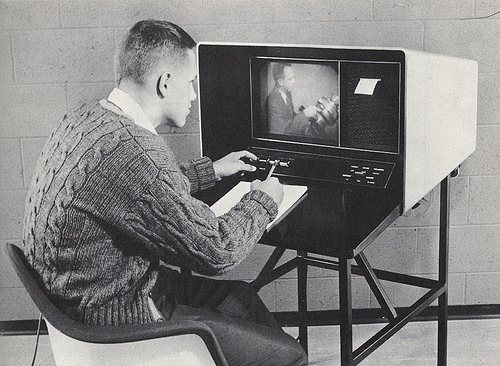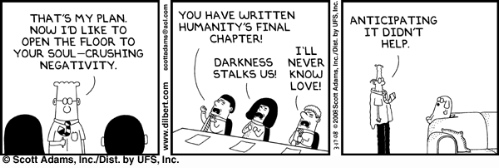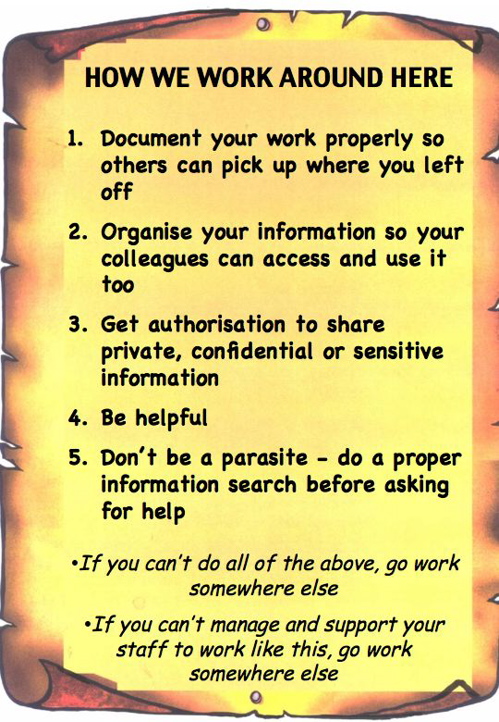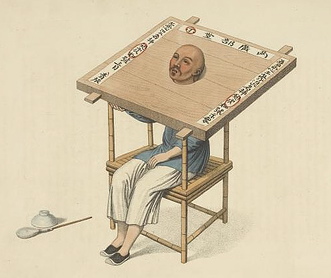Mar 18
We’ve Been Imagined
From Derrick Bostrom a collection of scanned photos from a 1962 book by Arnold Barach, predicting what the role of technology in our (white middle class) lives would be in 1975. I was particularly taken with these images of how technology could be used to assist learning in that then-distant future. Sigh. We haven’t come very far in the last 46 years. I think the best use for these photos is to hold them in store for when an over-enthusiastic elearning vendor tells you how innovative their technology is.

“Teacher’s Helper. In this classroom, the lesson and questions-in spelling, history, geography, and other subjects-are on a series of stacked cards at the top of the device. The student answers the questions by pushing one of four buttons. If he pushes the right one, the page drops down, revealing the next step in the lesson. The machine also scores each student, thus spots the slow learners for the teacher.”

“Push-Button Learning. Teaching machines break complicated subject matter into bit-by-bit segments, permitting each student to progress at his own pace. This machine, for example (called the “AutoTutor” ), first presents a unit of information. Then come questions based on what the student has learned, together with alternate answers. If the student presses the right buttons for the answers, he is “rewarded” with a new unit of study which appears on the machine. If he flubs the answers, a paragraph of text appears on the screen setting him right, and then he tries again. On the right is a classroom demonstration of the machine—a scene that will be commonplace in future years in most schools.”

“Film Based Teaching Machine. Student pushes one of four buttons to give answers and his score appears on paper slip at upper right. Teaching machines, expected to boom in the next decade, usually operate on the principal of repetition until the pupil understands. They aim to speed up the learning process and relieve teacher of much paper work in the classroom.”
Mar 18
Evaluating Impact: Making Sense of KPIs
From Brad Hinton this very nice experience-based account of how to use metrics to evaluate impact. He’s discussing how he used metrics in a library services setting, but quite rightly makes the connection to KM – the connection makes sense for any infrastructural services role in my view. Brad’s most telling connection (and the most frequently missed by metrics-fanatics) is how important it is to establish the narrative context of impact with stakeholders, which then helps you (and them) make sense of what the quantitative metrics you have uncovered actually mean.
“Sometimes we can get caught up with a set of formal metrics of measurement that yield outputs but do not reflect impact. And one way to ascertain impact is through talking to your clients and the people you service.”
For more on this see our white paper on “How to Use KPIs in Knowledge Management”.
Mar 18
This Happened to Me Last Week
Ain’t it wonderful how someone else’s wonderful encapsulation of your own experience can completely subvert its pain? (The original is here).

Mar 17
Intranet Innovation Awards
The floodgates are now open for nominations for StepTwo Designs’ 2008 Intranet Innovation Awards. Our company Straits Knowledge is a supporting organisation again, for this the second year of the awards. We like the way the awards are focused on showing practical benefits for the organisation, and also the flexibility in allowing nominations for any useful innovation, even if not large scale. Small can be beautiful too. Check out the videos from last year’s winners, for a taste of what can be done. And a special message from James Robertson for our Singapore friends: “It would be great to have some more Singaporean entries this year”. Come on, you know you deserve an award.
Mar 13
Guess What We Do…
I spent yesterday working with a client (among other things) to help them figure out whether they needed a vision statement and what was the best way to develop one.
So today I was tickled by this – not exactly a vision statement, but a statement about “Who are we?” – because it’s so visionary I have no idea at all what it means. Can you guess what they do?
”[We] bring to the boardroom the following qualities:-
We combine an unusual openness and passion for beauty and style with confidence and a down-to-earth sensibility which allow us to realise your vision. We consider many alternatives to get that done.
The full spectrum of possibilities in the business world intrigues us —we are not limited by pre-conceived notions of how things should be.
Problem-solving is a speciality, owing to our persistence, curiosity, and understanding of how things work.
Your vision allows us to identify what’s missing from a given situation, and our creativity allows you to fill the market gaps. Our awareness of how things function gives you the ability to come up with new uses for common objects.
We are practical within clearly defined budgets, creative knowledge wealth adherents who pay close attention to the details that others tend to miss”
No? Go find out...
Mar 12
Failing to Learn
I love this initiative started up by David Williams of actKM arising out of a contribution by Suzanne Zyngier. It’s a wikipage on KM failures case studies. I’ve added an additional page for folks to add their own personal anecdotes of KM failures. No more those Hollywood ending-ed case studies, begone! Let’s in with learning from the real world! Go and tell your story today…

Photo credit: Adam Baron
Mar 12
How Hard Can It Be?
We do a fair amount of work trying to help organisations influence their cultures for the better. Some of this work involves helping them develop clearer policies and guidelines to encourage consistent, open behaviours.
But it’s typically a slow, hard journey. I sometimes wonder if we’re all being too soft and sophisticated for what should be a very simple nut to crack. Why should the short code of behaviour given below be hard to implement? Isn’t our problem simply that we’re just too tolerant of bad behaviours?
PS: Do you want to test how committed your senior management team really is to KM? Don’t look at the KM budget; ask them if they are prepared to fire anyone (ANYone) who doesn’t adhere to the Code – and then hold them to it.

Mar 10
Turning Around Poisonous Cultures
A great post from Shawn at Anecdote on the leadership behaviours that affect organisational culture:
- What leaders pay attention to, measure, and control on a regular basis
- How leaders react to critical incidents and organisational crises
- How leaders allocate resources
- Deliberate role modelling, teaching, and coaching
- How leaders allocate rewards and status
- How leaders recruit, select, promote, and excommunicate
And then there’s a real stinger of a question: how do you turn around a culture that is already poisonous, where the leadership are doing all of the above in a way that destroys trust and collaboration? I’ve worked in, and consulted with dysfunctional cultures for many years… Despite the sophistication of my education and the range of influencing and change tools made available to me, I’m still with the “slaughter a chicken to scare the monkeys” school of thought (some people are just born brutal). But what about when you’re not in a position to slaughter chickens (eg when you’re “just a consultant” )?

Mar 08
A Hard Question
Brad Hinton asks a hard question:
“What I find particularly fascinating is the attention business gives to interest rate increases of .25% when many of the same businesses show a lack of interest in discovering and delivering .25% improvements to the bottom line by improving work practices and knowledge flow.”
Mar 07
CSI Recast
Nathan Wallace blogs infrequently, but every time he does, he makes a wave. His February 21 post could serve as a manifesto for any technology initiative but especially so for KM platforms such as intranets, content management systems, social software agglomerations. At its heart is the mantra, Clarify, Simplify, Implement:
“Clarify: Work with key stakeholders to understand drivers behind the process. Question motives and key assumptions. Turn over all the rocks to see what lies underneath. (In traditional software terms, this is requirements gathering.)
Simplify: Relentlessly question, review and challenge the processes and solution being developed. Drive for consistency. Search for well-known models or applications you can copy. Don’t be afraid to change basic assumptions, where simplicity can be enhanced. Always challenge the value of edge cases and try to eradicate them. Work hard to remove every single process, click, page view, icon, etc until you have something so simple that it feels right to everyone involved. (This is the primary value adding activity for IT.)
Implement: After the requirements are clear, and the solution distilled to its simplest form, start implementing. Do not start with a preconceived solution. Continue to loop through clarify and simplify while performing the implementation. (Use your preferred development methodology, provided it supports constant change and rapid prototyping.)”
He’s got some other great guiding principles to go along with the mantra:
Tough love adds value (on the importance of honesty and trust)
Brutal refinement (on doing the hard slog of making sure the detail works)
Zero training (if you have to train the users, you’ve failed)
Stay simple (on not losing your discipline after initial success)It’s a hard tack to carry through, it’s aggressive and it’s beautiful.

